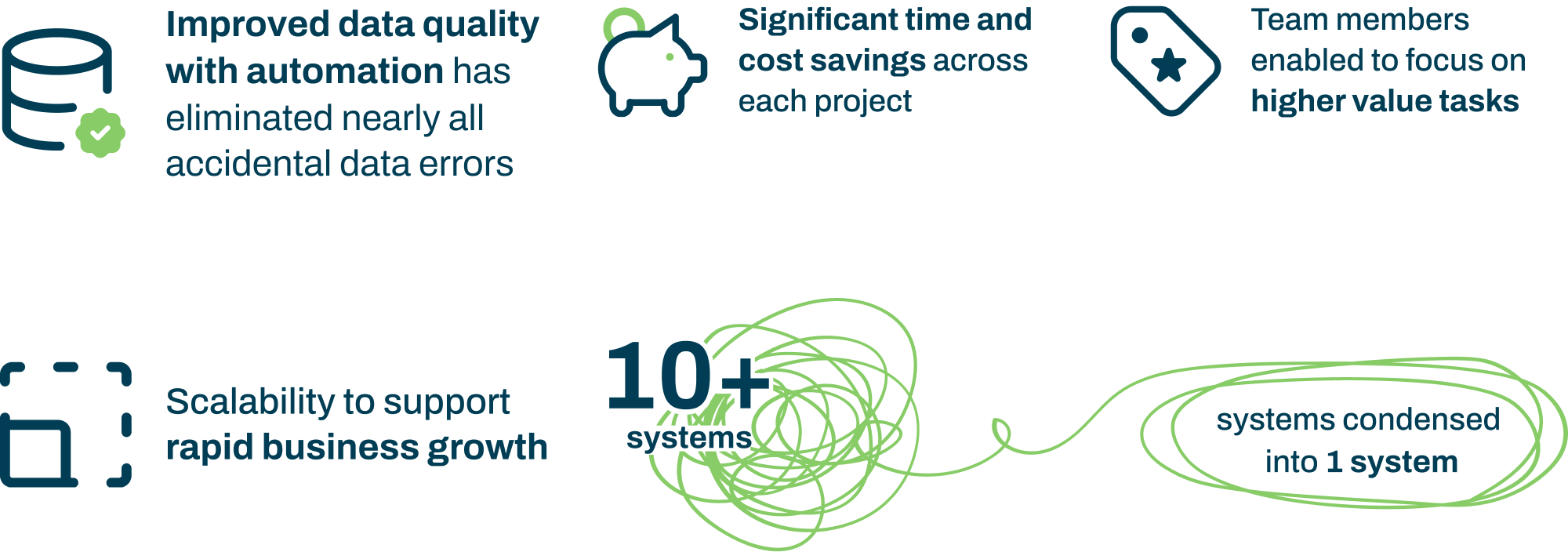Highlights

- 10+ systems condensed into one.
- Significant time and cost savings across each project, enabling team members to focus on higher value tasks.
- Scalability to support rapid business growth without the need for linear headcount growth.
- Improved data quality as the automated process has eliminated nearly all the accidental data errors.
The Problem
The client company’s clinical quality review service process was largely manual and required team members to use various disparate systems with multiple handoff points to different users/roles. This led to inefficiencies in end-to-end processing and was a major problem for the company.
The main areas that needed to be addressed were simplification and data accuracy, as most of the data was previously manually transported between individuals and clinics via Excel / CSV files and other disparate systems. Additionally, operational inefficiencies were a significant issue as siloed and manual processes had led to higher costs and waste.
The Opportunity
The manual and inefficient process presented an opportunity for a more streamlined, automated system that could handle the complex workflows of the company’s clinical quality review service process. This would not only improve operational efficiency but also provide an opportunity for scalability to support the company’s rapid business growth. Moreover, the new system could potentially improve data quality and accuracy, thereby increasing trust and confidence in the data extracts.
The Solution
The technical solution involved a frontend UI using Blazor WebAssembly with .NET 6 and C# 10, and a backend WebAPI using ASP.NET Core with .NET 6 and C# 10. The team followed a clean architecture for software implementation. They also used automated code generation for service clients that are responsible for communication between frontend and backend applications using OpenAPI and NSwag.
As part of the workflows, the team implemented automated emails from the application using Send Grid. They also implemented containerised worker services to run automated background processes based on event triggers to process heavy data inputs, and update the end application with the status and data as it was processed.
The team developed Infrastructure as Code using Terraform to provision Azure Resources, Network, and Azure Active Directory configurations. They built CI/CD pipelines to build and then deploy the application, worker processes, and other resources into the development/staging/production environments. The solution also included the implementation of Authentication, Authorization, Data Persistence, and Business Services.
The team implemented complex business workflows to cover a number of scenarios. They used Azure services like Key vault, Application insights, App service, Storage accounts, AZ Functions, Event grid, SQL DB, virtual network with private endpoints, and 2 x Containers running background service. They also used frontend UI using Blazor WebAssembly with .NET 6 and C# 10, Backend WebAPI using ASP.NET Core with .NET 6 and C# 10, and a clean Architecture for software implementation.
- Simplification of processes: The solution condensed 10+ systems into one, simplifying the clinical quality review service process.
Increased operational efficiency: The automation led to time and cost savings across each project, enabling team members to focus on higher value tasks. - Scalability: The solution supports rapid business growth without the need for significant headcount growth.
- Improved data quality: The automated process has eliminated nearly all the accidental data errors.
- Faster, higher quality data extracts: The solution provides better auditing which increases trust and confidence in the data extracts.
- Realisation of a commercial opportunity: The solution leverages the application to identify cross-study insights.
- Enhanced collaboration: The agile development process facilitated feedback and collaboration from the client company’s SMEs.
Our Approach
The Discovery phase was the initial stage of the project, where the team conducted an in-depth analysis of requirements. This involved user journey mapping workshops, where the team worked together to understand the user’s experience and identify potential pain points in the existing system. They also developed UX wireframes, which are visual guides that represent the skeletal framework of the application. This helped the team visualise the structure of the application and plan its functionality.
The team also conducted an assessment and prioritisation of features. This was a crucial step to ensure that the most important and impactful features were identified and prioritised for development. The outcomes of this phase provided the customer with high-level estimates to feed into the internal business case, setting the stage for the next phase of the project.
The MVP (Minimum Viable Product) phase was the next step in the project. The team’s focus during this phase was on creating a release to support a single study through an automated workflow. The Mantel Group and the company SMEs (Subject Matter Experts) worked collaboratively to iterate on requirements to ensure the right outcomes would be delivered. This collaborative approach allowed for continuous feedback and adjustments, ensuring the solution was tailored to meet the specific needs of the project.
The release of the MVP into production was a significant milestone. It gave the business confidence that the solution could support key workflows and deliver operational efficiencies through a more streamlined process. It was also an opportunity to gather feedback and prioritise features for the subsequent phase, setting the foundation for the final phase of the project.
The Productionisation phase was the final stage of the project. The focus during this phase was on supporting more studies and scaling the solution. This phase enabled further operational efficiencies, delivered performance improvements, and increased support for scalability.
During this phase, the team added additional features to provide greater visualisation of data and progress, improved intelligence around automation, increased auditing, and customisation to support new studies of strategic importance to the business. These enhancements were crucial in ensuring the solution was robust, scalable, and capable of delivering the desired outcomes.